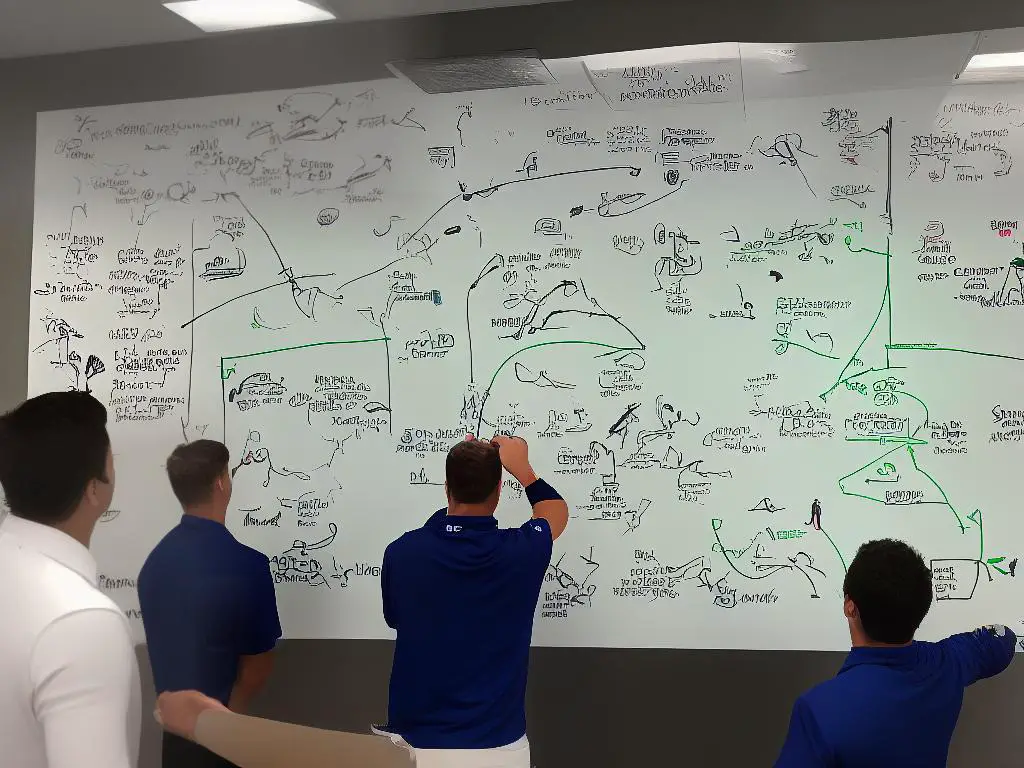Football Coaching Strategies Unveiled
Football coaching strategies encompass a wide range of key components that ultimately contribute to team success. From the essential principles and beliefs shaping a coach’s approach, to the offensive, defensive, and special teams tactics employed on the field, an in-depth understanding of these various strategies is vital for anyone interested in the world of football. By exploring elements such as game-planning, adjustments, strength, conditioning, player development, and motivation techniques, this essay will provide a comprehensive overview of the fundamental factors that make up an effective football coaching strategy.
Essential Coaching Philosophies
Team Culture
One of the most important coaching philosophies in football is creating a well-defined team culture. The foundation of a team’s success is built on the principles and values set forth by the head coach and their staff. These core values guide the team in their approach to football, both on and off the field. Establishing a strong team identity and culture is crucial in setting expectations and creating an environment that fosters growth, development, and success. The coach must understand and be able to clearly communicate their values while being consistent in their implementation.
Player Development
In addition to creating a team culture, it is crucial for football coaches to prioritize player development. Coaches must invest time and resources in ensuring that each player reaches their full potential. This can be achieved by appropriately tailoring coaching methods, drills, and individualized feedback to the skill level and learning abilities of each player. To maximize player development, coaches should constantly be assessing their players, setting goals and providing constructive feedback to help them improve.
Effective Communication
Effective communication plays a major role in football coaching. Coaches need to be able to communicate with their players in a clear and concise manner to get the message across. This not only involves verbal communication, but also nonverbal cues such as body language and facial expressions. Players need to understand what their coaches expect from them in different situations, and vice versa. Therefore, developing strong communication skills enables coaches to create a cohesive and successful team, where players understand the game plan, coaches’ expectations, and their respective roles within the team.
Coaching Styles
Coaching styles can vary greatly among football coaches, and it is important for each coach to find a style that works best for them and their team. Some coaches may adopt a more authoritarian approach – demanding discipline, focus, and respect from their players, while others might employ a more democratic or player-centered style, utilizing input from the team and allowing for a more collaborative approach. Each coaching style has its advantages and drawbacks, so it is essential for the coach to understand their own personality and how it affects their coaching style.
Adaptability and Continuous Learning in Football Coaching
Embracing adaptability and continuous learning is essential for success in football coaching. The game is constantly evolving, with new tactics, strategies, and training methodologies emerging regularly. Coaches who stay up-to-date with current trends, learn from their experiences, and adapt their coaching style and strategies accordingly will be more successful in developing their players and staying ahead of the competition. This can involve attending coaching clinics, workshops, or completing advanced coaching certifications to expand their knowledge and skills in the game.
Offensive Strategies
Offensive Formations as a Key Strategy
Building on the foundation of adaptability and continuous learning, one fundamental aspect of offensive strategies in football coaching is selecting the appropriate formation. Offensive formations are the arrangements of players on the field, which are designed to exploit specific advantages and create favorable matchups against the opposing defense. Common offensive formations include the pro set, the spread, the wing-T, and the option. Each of these formations has its strengths and weaknesses depending on the skill sets of the players on the team. A coach must analyze the abilities and talents of their players and adjust formations accordingly to maximize the potential for scoring.
Play-calling
Another crucial aspect of football coaching strategies is play-calling. This involves coaches choosing the specific offensive plays to be executed during a game from a pre-determined playbook. Good play-calling is essential in keeping the defense guessing and can lead to more successful offensive drives. Coaches must consider down, distance, field position, and the opposing team’s defensive tendencies when selecting a play. Additionally, coaches must be able to adjust their play-calling based on the flow of the game. For instance, if the team is trailing late in the game, coaches might call more passing plays to quickly move down the field and conserve time.
Exploiting Weaknesses
Effective offensive coaching strategies also involve exploiting an opponent’s weaknesses. This can be achieved by studying the opponent’s previous games and identifying tendencies in their defensive play. For example, if an opposing team struggles in defending against the run, the coach may focus on run-heavy plays and formations to capitalize on that weakness. In other cases, an offense may identify and target a specific defender they believe can be beaten in one-on-one situations. Coaches must then create game plans and make in-game adjustments based on these insights, ultimately aiming to expose and capitalize on the opponent’s vulnerabilities.
Tempo
Tempo is another offensive strategy coaches can employ to dictate the pace of the game and catch the defense off guard. By playing at a faster pace, offenses can prevent the defense from making timely substitutions and disrupt their ability to communicate. This can lead to a fatigued and disorganized defense that is more susceptible to making mistakes or allowing big plays. On the other hand, a slower-paced offensive strategy might also be effective in controlling the game clock, minimizing turnovers, and keeping the opposing team’s offense off the field. Coaches must determine the right tempo for their team’s style of play and skill set to maximize their offensive output.
Ball Security and Discipline
In football coaching, a crucial aspect of offensive strategies is to prioritize ball security and discipline. Turnovers, including fumbles and interceptions, can have a significant impact on a football game’s outcome. It is essential for coaches to teach proper ball-handling techniques and decision-making processes to minimize the risk of turnovers. Furthermore, discipline in avoiding penalties, such as false starts, holding, and illegal formations, is crucial, as these can hinder offensive drives and reduce scoring opportunities. By ensuring a well-disciplined and secure offensive unit, coaches can significantly increase their team’s chances of success on the field.

Defensive Strategies
Defensive Formations and Strategies
Another key aspect of football coaching is formulating effective defensive strategies, which involve the utilization of various defensive formations. A defense is typically comprised of three main groups: the defensive line, linebackers, and the secondary, consisting of cornerbacks and safeties. Coaches organize these groups into different configurations based on factors such as down, distance, and anticipated offensive plays. Some common defensive formations include the 3-4, featuring three linemen and four linebackers, and the 4-3, with four linemen and three linebackers. Each formation provides unique advantages in defending against specific types of offensive plays, making it crucial for coaches to develop and adapt their defensive strategies accordingly.
Schemes
Schemes are another integral component of defensive coaching strategies. These refer to the overall game plan and specific plays designed to stop the opposition’s offense. For instance, a coach may employ a zone- or man-to-man coverage scheme, depending on the secondary’s strengths and weaknesses. Zone coverage involves defenders protecting specific areas of the field, while man-to-man coverage assigns individual defenders to specific offensive players. Balancing the use of these schemes while also making adjustments based on opposing personnel and game situation is crucial for a defensive coordinator.
Pass Rush
Pressuring the quarterback is also a critical aspect of a successful defense, as quarterbacks are often the focal point and playmakers of an offense. Coaching strategies can involve using various techniques to disrupt the quarterback’s rhythm and force errors, such as blitzes and stunts. Blitzes refer to sending one or more additional defenders (usually linebackers or safeties) to rush the passer, creating pressure by overwhelming the offensive line. Stunts are designed plays where defensive linemen and linebackers interchange their positions to confuse the offensive line, ultimately creating openings for a pass rush.
Run Defense
In addition to the pressure placed on the quarterback, coaches will focus on stifling the run game as well. Stopping the run is crucial because it can force the offense into more predictable passing situations. One technique coaches may utilize is "run fits," which involves defensive players filling specific gaps in the offensive line to prevent running lanes for the ball carrier. By ensuring that each defender is responsible for a particular gap and reacts quickly, this strategy aims to minimize the available space for a rusher, ultimately limiting offensive gains through the ground game.
Improving Tackling Techniques
A key defensive strategy in football coaching is ensuring that players use proper tackling techniques. Coaches often emphasize the importance of correct form and technique to help defenders bring down ball carriers effectively and safely. This involves maintaining a low center of gravity, keeping the head up, and wrapping up the ball carrier’s legs to prevent any extra yardage. By enforcing proper tackling techniques consistently, coaches can significantly impact their team’s ability to limit the opposing offense’s success during a football game.

Special Teams Strategies
Enhancing Special Teams Play
In addition to tackling techniques, another crucial aspect of football coaching strategies involves special teams play. Special teams dictate field position and create scoring opportunities through kickoffs, punts, and field goal attempts. Though these plays may not receive as much attention as offensive or defensive schemes, they can greatly influence a game’s outcome and should be a priority for any coaching staff. Therefore, it is vital for coaches to understand and implement effective strategies in these situations, so their team can perform at their best in all aspects of the game.
Kickoffs
Kickoffs are vital in setting up favorable field position for the team, with the goal of pinning the opponent deep in their territory. Coaches can choose between a variety of kickoff approaches, including directional kicks, squib kicks, and onside kicks, depending on the game situation and the team’s strengths. For example, a squib kick can be a great tool to catch the opposing team off-guard and limit the chances of a big return, while an onside kick can potentially give the kicking team possession of the ball in a critical game situation. Training the kickoff unit to execute these plays with precision is essential to their success.
Punts
Punts are another important aspect of special teams strategy, with their primary objective being to switch the field position and force the opposing offense to cover more ground. Coaches should emphasize the skills of hang time and directional punting to minimize the risk of big punt returns. Moreover, developing a competent punt coverage unit that can tackle effectively and maintain their lane assignments is vital in preventing long returns that can negate a well-executed punt.
Field Goal Attempts
Field goal attempts provide an opportunity for teams to collect points and can often be the difference between winning and losing a tight contest. To maximize the chances of success, coaches need to ensure that their field goal unit operates efficiently and reliably. This means emphasizing the consistency and accuracy of the kicker, as well as guaranteeing that the long-snapper and holder can perform their duties under pressure. Coaches might also invest in scouting their opponents’ tendencies to block field goals, adapting their protection schemes accordingly.
Uncommon Special Teams Situations
Football coaching strategies involve being prepared for unique or uncommon special teams situations. This may include analyzing specific opponents’ tendencies and preparing for fake punt or fake field goal attempts. These plays can catch the opposing team off-guard and lead to game-changing moments. To do this effectively, coaches need to diligently study film and develop comprehensive contingency plans in order to exploit their opponent’s vulnerabilities in special teams situations and potentially swing the game in their favor.

Game-Planning and Adjustments
Following special teams strategies, game-planning becomes another critical aspect of football coaching. It entails analyzing the strengths and weaknesses of a specific opponent and creating a tailored approach to exploit these vulnerabilities. Like with special teams strategies, coaches rely on comprehensive scouting reports and extensive film study to identify patterns and tendencies in the opposition’s play. By discerning areas in which their own team holds a competitive advantage, coaches can devise strategies to capitalize on these opportunities, ultimately increasing the likelihood of a successful outcome.
In addition to identifying areas for exploitation, coaches must also ensure their team is prepared to counter the strengths of the opposition. This may involve practicing specific defensive schemes or offensive plays designed to nullify the impact of particularly dangerous players on the opposing team. Moreover, coaches often utilize simulation exercises in practice to recreate game situations their team is likely to encounter, thereby helping players to familiarize themselves with the intricacies of the upcoming contest.
Once a comprehensive game plan has been devised, it is imperative for coaches to convey the information to their players in an easily digestible format. This may involve utilizing video footage, diagrams, and whiteboard sessions to illustrate key concepts and strategies. Moreover, coaches must prioritize clear and concise communication so that players understand their individual roles and responsibilities within the game plan. By ensuring players are well-versed in their objectives, coaches increase the likelihood that the game plan will be executed seamlessly on match day.
However, despite the best-laid plans, the fast-paced and unpredictable nature of football means that coaches must also be prepared to make in-game adjustments as necessary. These changes may be prompted by an opponent’s tactical switch, an injury to a key player, or the need to protect a lead or overturn a deficit. As such, coaches must possess a deep understanding of their own team’s strengths and weaknesses, as well as the ability to think on their feet and adapt the game plan as required.
A crucial aspect of football coaching strategies is the ability to strike a balance between sticking to a predetermined game plan and making real-time adjustments based on the evolving nature of a game. This requires coaches to continually evaluate the effectiveness of their tactics while remaining open to altering their approach if necessary. By refining their game-planning and adjustment skills, football coaches can maximize their team’s chances of success by leveraging the knowledge gained through scouting and preparation to exploit their opponent’s weaknesses and minimize their strengths.
Strength and Conditioning
Enhancing Performance with Strength and Conditioning Programs
Within the realm of football coaching strategies, strength, and conditioning play a significant role in a player’s overall performance on the field. Factors such as speed, agility, and power are highly dependent on a player’s body strength and endurance. Therefore, coaches incorporate comprehensive strength and conditioning programs into their training regimens to develop and maintain their players’ physical aptitude and enhance their performance throughout the season, seamlessly tying into the ongoing efforts to optimize in-game strategies and adjustments.
Targeting Specific Muscle Groups
To optimize the effectiveness of strength and conditioning programs, football coaches must identify and develop exercises that target specific muscle groups needed for their sport. For example, core strength exercises like planks, bridges, and rotational movements help stabilize the spine and contribute to improved balance and posture, which are essential for football players. Similarly, lower body movements, such as squats, lunges, and deadlifts, strengthen the legs and hips for powerful and efficient movements on the field.
Incorporating Plyometrics and Cardiovascular Exercises
Another essential component of strength and conditioning programs is the incorporation of plyometrics and cardiovascular exercises. Plyometrics, also known as jump training, focuses on generating maximum force in minimum time, ideally increasing the player’s power and explosiveness. Cardiovascular exercises, on the other hand, improve the players’ aerobic capacity, enabling them to maintain their energy levels during extended periods of physical exertion. By incorporating these exercises into the strength and conditioning program, coaches can develop well-rounded athletes capable of performing at their peak.
Injury Prevention Methods
Injury prevention methods are also a crucial aspect of strength and conditioning in football coaching strategies. Given the physically demanding nature of the sport, ensuring players’ safety is of utmost importance. Coaches can implement injury prevention strategies through various methods, such as emphasizing proper technique during strength training, incorporating dynamic warm-ups, and using sports-specific functional movement screens to identify muscular imbalances and weaknesses that may contribute to potential injuries. These measures can help ensure that players remain healthy and able to contribute to their team’s success.
Proper Recovery and Nutrition
Football coaching strategies must recognize the importance of proper recovery and nutrition for their players. These aspects greatly influence the effectiveness of strength and conditioning programs. Adequate rest and sleep, paired with appropriate nutrition, allow the body to repair itself and prepare for upcoming sessions, ultimately supporting ongoing physical development and preventing burnout. By placing equal emphasis on training and recovery, football coaches can create well-balanced programs that equip their players with the physical tools necessary for success on the field.
Player Development and Motivation
Player Development and Motivation
Building upon the foundation of recovery and nutrition, player development, and motivation are crucial aspects of football coaching strategies. Coaches play a significant role in nurturing player growth, both on and off the field. Ensuring seamless integration between physical development and mental growth can lead to a successful and motivated team.
Fostering a Positive Team Culture
Creating an environment where players feel supported and valued helps boost their confidence and encourages them to push beyond their perceived limitations.
Instilling Discipline
Setting clear expectations and consistently reinforcing values such as hard work, dedication, and accountability helps players understand the commitment required to excel in the sport. Adopting a fair and just disciplinary method for handling any issues that arise is essential in maintaining a team’s focus and unity.
Motivating Players
Identifying each player’s intrinsic and extrinsic motivations allows coaches to tailor their approach and provide the necessary encouragement and support to help them reach their highest potential.
Personalized Feedback and Goal Setting
Continuous assessment of a player’s performance allows coaches to identify areas that require improvement and offer guidance on how to make progress. Setting realistic, achievable goals enables players to take ownership of their development and feel a sense of accomplishment when they reach these milestones.
Mentoring and Support Systems
Pairing experienced players with younger or less skilled players can create a bond that promotes learning, growth, and motivation. This collaborative environment benefits both the mentor and the mentee, instilling a passion for the sport and a commitment to excellence that extends beyond the playing field.

Coaching strategies in football are as vital as they are complex, encompassing diverse and interconnected aspects of the game. Success on the field is not solely the result of talent or luck, but also the effective application of these strategies. The topics covered in this essay – from coaching philosophies and offensive, defensive, and special teams tactics, to game-planning, adjustments, strength, conditioning, player development, and motivation techniques – illuminate the necessary elements that constitute an effective football coaching strategy. Ultimately, both coaches and enthusiasts seeking to deepen their understanding of coaching strategies in football can gain valuable insight from this comprehensive examination of the subject.

